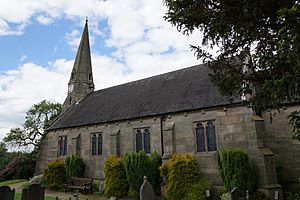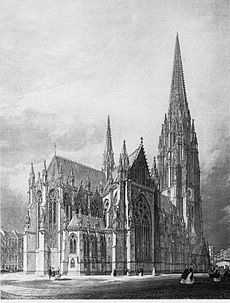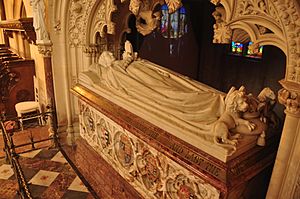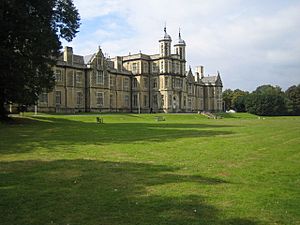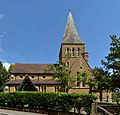George Gilbert Scott facts for kids
Quick facts for kids
Sir George Gilbert Scott
|
|
|---|---|
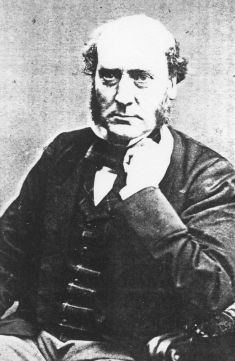
Sir George Gilbert Scott
|
|
| Born | 13 July 1811 Parsonage, Gawcott, Buckinghamshire, England
|
| Died | 27 March 1878 (aged 66) 39 Courtfield Gardens, South Kensington, London, England
|
| Occupation | Architect |
| Awards | Royal Gold Medal (1859) |
| Buildings | Wakefield Cathedral Albert Memorial Foreign and Commonwealth Office Midland Grand Hotel St Pancras railway station Main building of the University of Glasgow St Nicholas Church, Hamburg St Mary's Cathedral, Glasgow St Mary's Cathedral, Edinburgh (Episcopal) King's College Chapel, London Wanstead Infant Orphan Asylum |
Sir George Gilbert Scott (born July 13, 1811 – died March 27, 1878) was a very busy and famous English architect. He is best known for designing and fixing churches and cathedrals in a style called Gothic Revival. This style brought back the look of medieval Gothic buildings.
Even though he became famous for churches, he actually started his career designing workhouses, which were places where poor people could live and work. Sir George Gilbert Scott designed or changed over 800 buildings during his lifetime!
Some of his most famous buildings include the Midland Grand Hotel at St Pancras Station in London, the beautiful Albert Memorial, and the Foreign and Commonwealth Office building, also in London. He also designed St Mary's Cathedral, Glasgow, the main building of the University of Glasgow, and St Mary's Cathedral in Edinburgh.
Contents
Life and Career of a Master Builder
George Gilbert Scott was born in Gawcott, a small village in Buckinghamshire, England. His father was a reverend, and his grandfather was a well-known writer about the Bible.
Scott learned about architecture by working with other architects. From 1832 to 1834, he was an assistant to Henry Roberts. He also worked with his friend, Sampson Kempthorne, who was good at designing workhouses. This is where Scott began his own career.
Starting Out: Workhouses and Early Churches
Scott's very first building was a house for his father in 1833 in Wappenham, Northamptonshire. He went on to design several other buildings in that village.
Around 1835, Scott teamed up with William Bonython Moffatt. Together, they designed more than 40 workhouses over about ten years. Workhouses were buildings where poor people could get food and shelter in exchange for work.
They also designed some early churches, like St Mary Magdalene in Flaunden (1838) and St Nicholas in Newport (1839). They even built Reading Gaol (a prison) in a castle-like style.
The Rise of Gothic Revival
Scott was greatly inspired by another architect named Augustus Pugin, who loved the Gothic Revival style. This style aimed to bring back the grand, detailed look of medieval Gothic buildings.
While still working with Moffatt, Scott designed the Martyrs' Memorial in Oxford (1841) and St Giles' Church, Camberwell (1844). These projects helped him become well-known in the Gothic Revival movement.
The Martyrs' Memorial was built to remember three Protestants who were burned at the stake during the reign of Queen Mary I. St Giles' Church was praised for its "pure style" and traditional design, even though it had wooden galleries, which were not common in medieval churches.
In 1844, Scott won a big international competition to rebuild the Nikolaikirche in Hamburg, Germany. His design was the only one in the Gothic style, and it was chosen even though it initially came in third place. The church was completed in 1863.
In 1849, Scott became the official architect for Westminster Abbey, a very important church in London. In 1858, he designed ChristChurch Cathedral in New Zealand. This cathedral was badly damaged in an earthquake in 2011, but people are working to rebuild it.
Scott also designed the choir stalls at Lancing College in Sussex. These stalls featured many "green men" carvings, which are faces made of leaves, often seen in old churches.
Later in his career, Scott started to mix different styles into his Gothic Revival buildings. He believed that combining features from various European styles could lead to a new kind of architecture. A great example of this is the Midland Grand Hotel at London's St Pancras Station, which is made of red brick.
In 1863, Scott designed a new tomb for Catherine Parr, one of King Henry VIII's wives, at Sudeley Castle. The tomb was in a neo-Gothic style.
Between 1864 and 1876, the famous Albert Memorial was built in Hyde Park, London. Scott designed this grand memorial for Queen Victoria to honor her husband, Prince Albert, after he passed away.
Scott believed that Gothic architecture wasn't just for churches. He thought it could be used for other buildings too. He won a competition to design new government buildings in Whitehall, London, for the Foreign Office and War Office. However, the new Prime Minister, Palmerston, didn't like the Gothic style for these buildings. After some discussion, Scott had to create new plans in a different, more accepted style.
Scott also designed the memorial to Thomas Clarkson in Wisbech. This memorial was finished after Scott's death by his son, John.
Awards and Recognition
Scott received the RIBA's Royal Gold Medal in 1859, which is a very high honor for an architect. On August 9, 1872, he was made a knight, and from then on, he was known as Sir Gilbert Scott.
He passed away in 1878 and was buried in Westminster Abbey, a place he had worked on for many years. A special "blue plaque" (which is actually brown) was placed on his former home in Hampstead, London, to remember him.
Family of Architects
Sir George Gilbert Scott married Caroline Oldrid in 1838. Architecture seemed to run in the family! Two of his sons, George Gilbert Scott, Jr. and John Oldrid Scott, became important architects themselves. His grandson, Giles Gilbert Scott, also became a very famous architect, known for designing the iconic red telephone boxes and Battersea Power Station.
His youngest son, Dukinfield Henry Scott, became a botanist (someone who studies plants).
Learning from the Master
Scott was so successful that many young architects wanted to learn from him. He had many students who went on to have successful careers of their own. Some of his notable students included George Frederick Bodley, Thomas Graham Jackson, and George Edmund Street.
Books and Writings
Besides designing buildings, Scott also wrote books and many articles, letters, and reports about architecture. He shared his ideas in magazines like The Builder and The Ecclesiologist.
Amazing Architectural Works
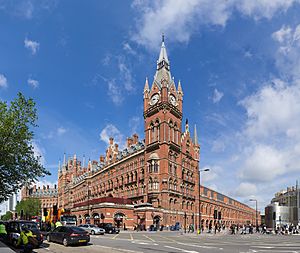

Here are some of the many buildings Scott designed or worked on:
Public Buildings and Schools
- Workhouses in many towns like Winslow, Buckinghamshire (1835), Guildford, Surrey (1836–38), and Loughborough, Leicestershire (1837–38).
- Infant Orphan Asylum, Wanstead, Essex (1841–43), which is now a court building.
- Martyrs' Memorial, Oxford (1841–43).
- Reading Gaol, Berkshire (1842–44).
- Brighton College, Sussex (1848–1866).
- Sandbach School, Sandbach, Cheshire (1849).
- Foreign and Commonwealth Office, Whitehall, London (1861–1868).
- Preston Town Hall, Lancashire (1862–67), which was sadly destroyed by fire in 1947.
- The main building of the University of Glasgow (1870).
- The Albert Memorial, London (1864–72).
- Midland Grand Hotel, St Pancras Station, London (1865).
- McManus Galleries – formerly the Albert Institute, Dundee (1865–69).
- Clifton Hampden Bridge, Oxfordshire (1867).
- The University Senate Hall and the Rajabai Clock Tower at Mumbai University (1869–78).
- The Clarkson Memorial in Wisbech (finished 1881).
Homes and Private Buildings
- Vicarages (homes for priests) in places like Wappenham, Northamptonshire (1833) and Dinton, Buckinghamshire (1836).
- Workers Houses, Hartshill, Stoke on Trent (1842–48).
- Lanhydrock House, near Bodmin, Cornwall (1857), a large Elizabethan mansion rebuilt after a fire.
- Kelham Hall, Nottinghamshire (1859–62).
- Hafodunos, Llangernyw, North Wales (1861–1866).
- The Master's House, St John's College, Cambridge (1863).
Churches and Cathedrals Designed by Scott
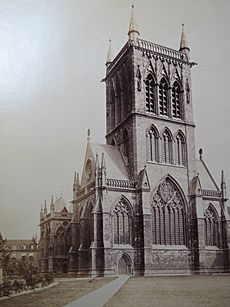
- St Giles' Church, Camberwell, London (1841–44).
- St Nikolai, Hamburg (1845–80), which was the tallest building in the world for a short time.
- The Cathedral of St John the Baptist in St John's, Newfoundland, Canada (1847).
- Chapel of Exeter College, Oxford (1854–60).
- St George's Minster, Doncaster (1858).
- All Souls Church, Halifax (1859).
- St Matthew's Church, Stretton, Cheshire (1859 and 1867).
- The Hereford Screen (1862), a beautiful choir screen from Hereford Cathedral, now in the Victoria and Albert Museum in London.
- Chapel of Wellington College, Berkshire (1861–63).
- St Andrew's Church, Derby (1864–67).
- Holy Trinity Church, Shanghai (1866–69).
- St Mary's Church, Mirfield (1869–1871).
- The Cathedral Church of St Mary the Virgin, Glasgow (1873).
- St Saviour's Church, Leicester (1875–77).
- All Souls, Blackman Lane, Leeds (1879) – his very last church design.
- St Michael and St George Cathedral, Grahamstown, South Africa (tower and spire completed in 1879).
- ChristChurch Cathedral, Christchurch, New Zealand.
- St Mary's Cathedral, Edinburgh (Episcopal).
Restoring Old Buildings
Scott was also famous for "restoring" many old medieval churches and cathedrals across England. This often meant fixing them up, adding new parts, or changing them to look more like they might have in the Middle Ages.
Churches Restored by Scott
- Church of St Peter and St Paul, Buckingham, Buckinghamshire.
- St Mary's Church, Sandbach, Cheshire (1847).
- St Mary Abbots, Kensington, Greater London (1872).
- St Margaret's Church, Westminster, Greater London (1877–78).
- St Wulfram's Church, Grantham, Lincolnshire (1866–75).
- St Mary's Church, Kingston upon Hull, East Riding of Yorkshire (1861–63).
- Chantry Chapel of St Mary the Virgin, Wakefield, West Yorkshire (1842).
Cathedrals Restored by Scott
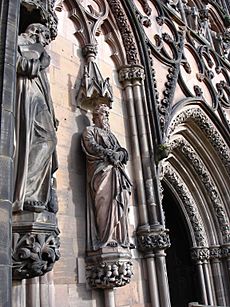
Scott worked on many of England's most important cathedrals, including:
- Ely Cathedral (1847–78).
- Gloucester Cathedral (1854–76).
- Peterborough Cathedral (1855–60).
- Lichfield Cathedral (1855–61 & 1877–81) – its beautiful West Front was a major project for him.
- Wakefield Cathedral (1858–60, 1865–69 and 1872–74).
- Durham Cathedral (1859 and 1874–76).
- Canterbury Cathedral (1860 & 1877–80).
- Salisbury Cathedral (1865–71).
- Chester Cathedral (1868–75).
- St Albans Cathedral (1871–80).
- Winchester Cathedral (1875).
Abbeys and Priories Restored by Scott
He also restored many abbeys and priories, which are large churches that were once part of monasteries:
- Beverley Minster (1844, 1866–68, 1877).
- Westminster Abbey (1848–78).
- Bath Abbey (1860–77).
- Pershore Abbey (1861–64, 1867).
- St George's Chapel, Windsor Castle (1863).
- Tewkesbury Abbey (1874–79).
Scott also restored the Inner Gateway of Reading Abbey after it partly collapsed. He worked on Sudeley Castle, restoring parts of it to match its old medieval and Elizabethan styles.
Gallery of Architectural Work
-
Holy Trinity Church, Halstead, Essex (1843–44)
-
The Chapel, King's College London (1861–62)
-
Screen from Hereford Cathedral (1862) now in the Victoria and Albert Museum
-
St Mary Abbots Church, Kensington (1870–72)
-
Clarkson Memorial, Wisbech, (1880–81)
-
St Barnabas' Church, Bromborough, Merseyside (1862–64)
See also
 In Spanish: George Gilbert Scott para niños
In Spanish: George Gilbert Scott para niños
- List of works by George Gilbert Scott


